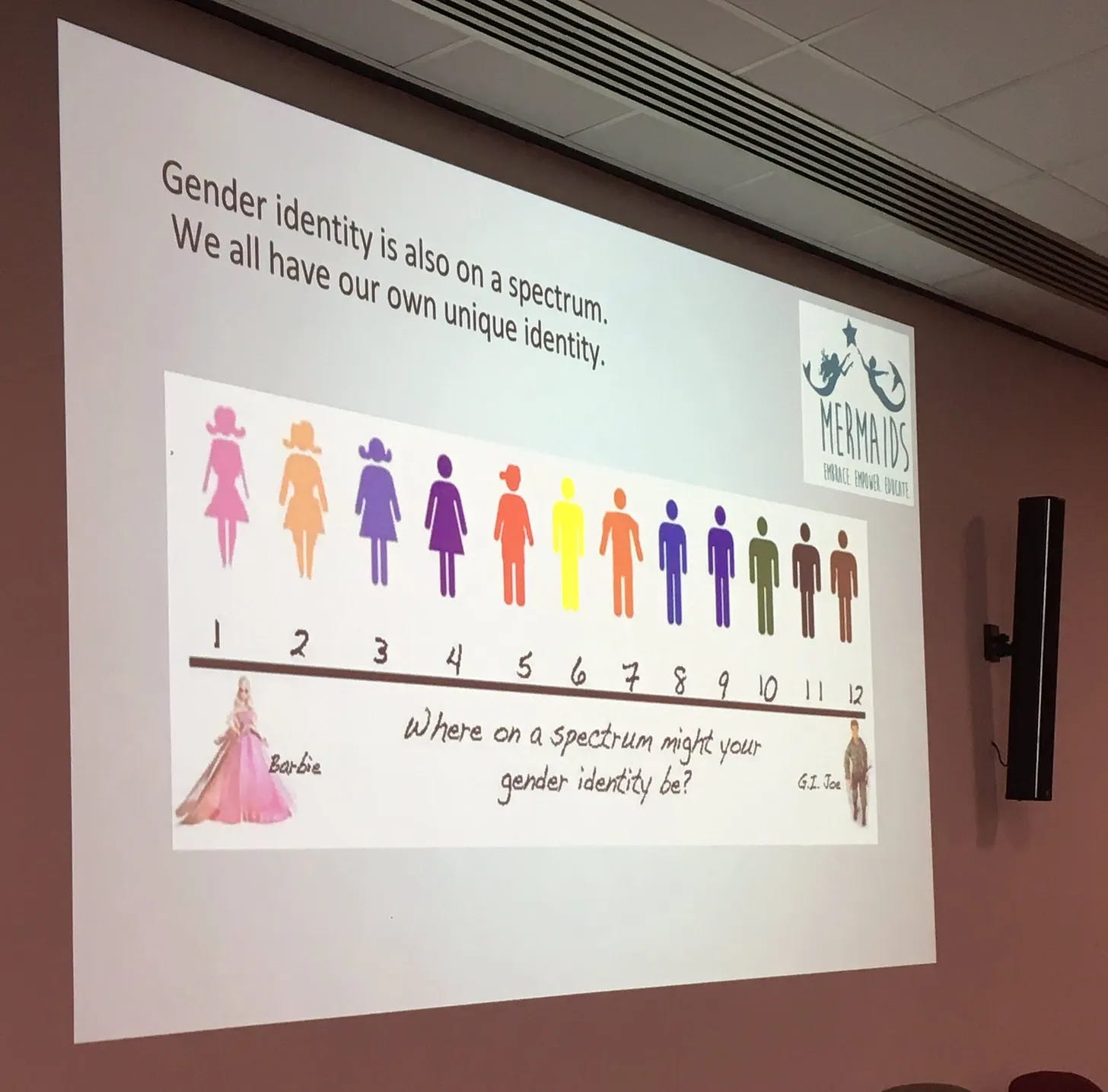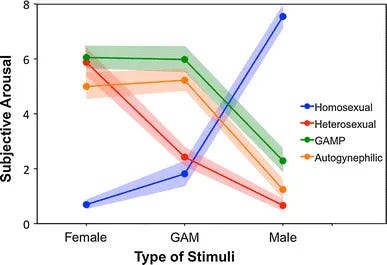This memo shows that teaching children (by charities, schools and non-governmental organisations) that “trans” is a matter of a mismatched “gender identity” is not the truth, and is causing a psychological contagion, primarily amongst girls.
To stop this psychological contagion, this memo suggests teaching children about “trans” and “gender identity” should cease, and children who experience disorders of cross-sex identification be handled on a case-by-case basis.
Furthermore, this memo shows that the belief that transsexuals (defined as those who take medical steps to change their secondary sex characteristics) are in some way literally the other sex — have the “gender identity” of the opposite sex — is unsupported by research.
This memo argues that the medical community are not being guided by research, but rather by this belief in a “gender identity”, and are causing harm to those who are approaching them with distress regarding matters of personal cross-sex identification. They are providing supposed care to children based on this belief, which these children cannot consent to.
Although this memo is focused on the United Kingdom, the examples within will be applicable to other countries who are facing this issue.
What has been happening?
Over the last decade, there has been a drastic increase in the number of child and adolescent referrals regarding “gender dysphoria” — the unhappiness with one’s sex
In 2010, there were a handful of children being referred, primarily boys. Since then, the ratio has changed: now girls are the vast majority that are being referred to “gender identity” clinics.
Why is this happening?
Charities present “trans” as a vague concept:
There is no right or wrong way to be trans…. - Stonewall
Trans: An umbrella term to describe people whose gender is not the same as, or does not sit comfortably with, the sex they were assigned at birth. - Stonewall
We use trans as an umbrealla [sic] term and are fully inclusive of non-binary individuals; please don't worry about not feeling 'trans enough’ - Gendered Intelligence
Stonewall introduce the concept that “sex” is a social construct, “assigned” by doctors, rather a material reality. Gendered Intelligence present “trans” similar to a club that you can join, with no clear definition.
Mermaids present children with a diagram that how well you conform to averages of sex-based behaviour determines whether you have a “male” or “female” “gender identity”, with no space for feminine boys, nor masculine girls:

History suggests that teaching a loose definition of a psychological condition to children, particularly girls, is not a good idea, as this cohort is susceptible to socially-contagious mental health issues.
In Hong Kong, for example, there had never been an epidemic of “anorexia” until their local media publicised the “Western ailment” of anorexia nervosa, which had been responsible for a girl’s death.1 There was an outbreak of girls presenting with symptoms afterwards. This has happened multiple times through history:
The Salem witch trials of the seventeenth century […] nervous disorders of the eighteenth and neurasthenia epidemic of the nineteenth century. Anorexia nervosa, repressed memory, bulimia, and the cutting contagion in the twentieth. One protagonist has led them all, notorious for magnifying her own psychic pain: the adolescent girl. Her distress is real. But her self-diagnosis, in each case, is flawed—more the result of encouragement and suggestion than psychological necessity…Today’s diagnostic craze isn’t demonic possession, it’s “gender dysphoria.” And its “cure” is not exorcism, laxatives, or purging. It’s testosterone and “top surgery”.2
It appears therefore likely, that there is not an internal cause that explains why so many girls are being referred to “gender identity” clinics, but rather an external cause: teaching children loose definitions of “trans”.
Providing medical treatment to this cohort will therefore be harmful. This harm has already been covered numerous times in the media: for example, in the UK, a young woman, Kiera Bell, brought a legal case against the NHS after being harmed by the supposed treatment she was provided with by the now-closed Tavistock and Portman NHS trust “gender identity” clinic:

These harms are increasingly being reported:
“The mothers left distraught after the NHS removed their daughters’ healthy breasts because the girls said they were transgender” (Daily Mail, 27th February 2025)
“Revealed: More than 1,000 patients a year have trans chest surgery on the NHS” (Telegraph, 10th February 2025)
“Father's letter begging top surgeon to cancel trans operation on ‘depressive’ 20-year-old: ‘Please don't remove my daughter's breasts ...in just one day you'll ruin her life for ever’” (Daily Mail, 27th July 2024).
“I was desperate to be a boy and to have my breasts removed. Now I realise I was a girl all along — and this is why” (Daily Mail, Helen Carroll, 3rd April 2025).
"Breastfeeding grief after chest masculinisation mastectomy and detransition: A case report with lessons about unanticipated harm" Karleen D Gribble, Susan Bewley, Hannah G Dahlen. Frontiers in Global Women’s Health. 2023 Feb 3:4:1073053.
A surgeon, writing anonymously, has found that there is nobody who will take responsibility for these surgeries. A General Practitioner, writing anonymously, will not prescribe so-called “gender affirming care” treatments, as they know that this issue is a scandal.
There is no medical treatment that is appropriate for this cohort of girls and young women, who are falsely self-diagnosing themselves as “trans”. The cure is rather to be found in charities, schools and non-governmental organisations stopping teaching children a loose, vague definition of “trans” and “gender identity”.
The content that charities and non-governmental organisations are teaching children — that “trans” is a matter of a “trapped” “gender identity” — is also not the truth.
The causes of male cross-sex identification
The idea that “trans” is explainable by an apparent “gender identity” “trapped” in the wrong body is contested.
The concept of “gender identity” used in this way can be seen as a continuation of what researchers called, in the case of males identifying as women, the “feminine essence narrative”, which suggests that “Male-to-female transsexuals are, in some literal sense and not just in a figurative sense, women inside men’s bodies”3 — that “trans women are women”.
In disagreement with the “feminine essence narrative”, researchers instead see that cross-sex identification is in fact a matter of atypical sexuality, or sexual orientation. In the late 1980s, a researcher named Ray Blanchard — later to serve on the gender identity disorder subcommittee of the DSM-4 — posed that the root cause for all male-to-female cross-sex identification was a matter of either homosexuality, or autogynephilia, which is a word he coined that meant “love of the concept of oneself as a woman”.4 In the DSM-5, these “two types” of cross-sex identification disorder are recognised as “early-onset”, and “late-onset”.
Homosexual cross-sex identification
The first, early-onset, in the case of males, is characterised as being when a particularly feminine boy has the persistent wish to be a girl. At the onset of puberty, they will usually find that they are homosexual, and this persistent wish will, in the majority of cases, stop.56
Autogynephilic cross-sex identification
The second type, autogynephilic, or late-onset, occurs at puberty, when an otherwise masculine boy, might suddenly declare that they want to be a woman, or a man might suddenly present as wanting to be a woman in later life, even after marriage and having children.
Blanchard writes that the cause of this type of cross-sex identification is also connected with sexual orientation. In this case, rather than a heterosexual male being oriented solely towards women in the outside world, they are also oriented to the concept of themselves as a woman:
Gender identity disturbance in males is always accompanied by one of two erotic anomalies. All gender dysphoric males who are not sexually oriented toward men are instead sexually oriented toward the thought or image of themselves as women. … the writer would prefer to replace it with the term autogynephilia (“love of oneself as a woman”).7
The phenomenon of autogynephilia appears less well known as homosexuality, as not every male who experiences it will find themselves compelled to adopt the outward identity of a woman.8 In itself, autogynephilia is neither a disorder nor a diagnosis — for most it will be an entirely private experience:
History of autogynephilia
Although Blanchard coined the word “autogynephilia”, it is not a modern phenomenon and can be observed in history. The researcher Henry Havlock Ellis recognised the phenomenon in the 1930s, and named it “Eonism”, after the Chevalier d'Éon, the cross-dressing French diplomat:
On the psychic side, as I view it, the Eonist is embodying, in an extreme degree, the aesthetic attitude of imitation of, and identification with, the admired object. It is normal for a man to identify himself with the woman he loves. The Eonist carries that identification too far…9
It is likely that David Bowie had autogynephilia, given he cross-dressed both on stage, and at home, and at one point had a relationship with the male-to-female homosexual transsexual Romy Haag, as the attraction, gyneandromorphophilia, in this relationship correlates with autogynephilia.10
Bowie’s apparent ambiguous bisexuality would also be explained by what Blanchard termed “pseudobisexuality”.11 For a male with autogynephilia, men are not the target for romantic or personal attraction, but are rather “faceless” props, used only insofar as they further the conceit of the attraction to the concept of oneself as a woman.
The recurring phenomenon of autogynephilia through time and place suggests that there is is innate propensity behind the phenomenon. Blanchard considered the question of whether or not autogynephilia is innate in an interview:
I don’t think that people are born with fully formed paraphilias, fully formed specific paraphilic interests and I don’t think that anybody is born with a fully-formed cross-gender identity. What I think is that people are born with predispositions or vulnerabilities to a kind of erotic miss-learning, which then predisposes them to things like autogynephilia, perhaps it predisposes them to develop a cross-gender identity […]
I don’t think think people are born with that specific crystallised paraphilia, but I think they are born with some sort of defect, where erotic learning is not self-correcting… some paraphilias definitely cluster: autogynephilia and masochism, for example, and autogynephilia, masochism and what we might call “stuff fetishism”: fetishism for particular materials, like leather, silk, rubber… it’s not completely at random…12
The preference for certain types of materials is recognisable in contemporary accounts of autogynephilia, which reference such preference for certain fabrics:
Playing with her long, dark hair, she explains how from that first moment she took every covert opportunity to try on her mother’s clothing, favouring nightdresses and floral skirts. At secondary school, she would wear tights under her school trousers, enjoying how they felt against her skin.

The correlation between autogynephilia and “stuff fetishism” can again be observed below. In in this case, Abigail Thorn’s apparent autogynephilia correlates with a preference for wearing rubber (below).


The idea of autogynephilia as a misdirected sexual orientation is compelling, when one observes examples of cross-sex identification. The impression is arguably that of an otherwise masculine male who is not searching for a girlfriend in the outside world, but who searches for their girlfriend in the internal world of the concept of themselves as a woman. As Blanchard notes:
It should be noted that the concept of autogynephilia does not imply that autogynephilic males are always sexually aroused by the thought of themselves as women, or by dressing in women's clothes, or by contemplating themselves cross-dressed in the mirror - any more than a man in love always obtains an erection at the sight of his sweetheart, or pair-bonded geese copulate continuously.13

Why “gender identity”?
The two-type theory of male cross-sex identification, of homosexuality and autogynephilia, is arguably the truth about “trans”, however was met with a backlash particularly amongst transsexual male activists who preferred to believe in the narrative of the “trapped” “gender identity”, for political and psychological reasons.
These activists in particular targeted a contemporary of Blanchard, J. Michael Bailey, in a campaign of harassment after the publication of his book The Man who would be Queen, which covered the research on the two-type theory in a popular manner easily accessible to the public.14
Alice Dreger, a bioethicist who whose work included campaigning for the rights of people born with disorders of sexual development (DSDs), described the issue:
The shame and derision accorded trans women like Juanita and Cher [the two male-to-female transsexuals described in the book] doesn’t disappear just because a few scientists may be personally fine with the idea that men might become women primarily because of reasons of sexuality, not “trapped” gender identity… the trans women who attacked Bailey for his book understood that the world would probably not agree… They wanted the whole business of Blanchard’s taxonomic division shot down. Transsexuality should appear only as the public could stomach it, as one simple story of gender, a tale of “true” females tragically born into male bodies, rescued by medical and surgical reassignment. And there should be absolutely no mention of autogynephilia or any other sexual desires that might make trans women look to the sexually sheltered like the perverts they were historically assumed to be.15
It is arguable that many of these activists were delusional, autogynephilia can create an identity disorder, and genuinely believed that they had a female “essence” — or “gender identity”. The campaign of harassment appears therefore not only motivated by political reasons, but also for personal psychological reasons: to avoid shattering the delusion that they were in fact, males with an atypical sexuality. Anne Lawrence, an autogynephilic transsexual, writes in the book book Men Trapped in Men’s Bodies:
The theory of autogynephilic transsexualism forces us to confront the fact that both our essential natures and our motives seem to directly contradict our desired ends. We autogynephilic transsexuals want to be women; but the theory tells us that we are not women and that we don’t even resemble women—not in the least. We would like to believe that our desire to be women springs from our need to express some internal feminine essence; but the theory tells us that we have no internal feminine essence and that our desire to be women actually springs from our paraphilic male sexuality.16
Today, knowledge of the two-types of male cross-sex identification has been shut-down. In its place, the belief that transsexuals literally have the “essence” or “gender identity” of the opposite sex prevails.
As a result, males with autogynephilia, who have a propensity for cross-sex identification, are being told by every position in authority, by schools, charities and non-governmental organisations, that what they are feeling, literally makes them in some way the opposite sex.
Whereas in previous generations, many boys and men with autogynephilia would have kept their experience of autogynephilia private, or tried to integrate the phenomenon with their male identity, now, the belief in “gender identity” is revealing the latent phenomenon of autogynephilia. Increasingly more males are now “coming out” as “trans women” with the belief that they have a female “gender identity”.
Despite J. Michael Bailey, and his family, being attacked by those wishing to suppress research on autogynephilia, Bailey remains of the opinion that those hurt the most regarding the suppression of research, are males with autogynephilia themselves.17
Not every male who experiences autogynephilic cross-sex identity disorder is invested in a delusion of womanhood, but rather many are trying the best they can to understand what they are feeling: they are not being served by the myth that they have the “gender identity” or “essence” of the opposite sex, which can lead to a dangerous pathway towards inappropriate medical intervention.
The medical profession
It is arguable that the medical profession have abandoned research-led care and are now captured by a belief in “gender identity”, leading the medical community to to harm, rather than help those who approach them, regarding their distress related to cross-sex identification.
Medical professionals cannot give the advice to parents of remarkably feminine boys that they will likely grow out of their cross-sex identification at the onset of puberty, and can discount the narratives of older typically masculine males with autogynephilia.
Neither can they give advice to parents of girls, that statistics and history suggest they are likely suffering from a social contagion.
Medical professionals cannot give this advice, as to do so would be to undermine the belief that it is possible for someone to know their own “gender identity”, and that cross-sex identification is solely a matter of a “trapped” “gender identity”. The medical profession is arguably providing supposed treatments based on this belief, rather than evidence.
Blanchard talks about how the pathway to medical treatment has changed:
Blanchard: Oh, for sure. I mean, the people who approve, who are in favour of transition in children, who are in favour of earlier medical interventions, whether it’s puberty preventing medications, whether it’s testosterone for young girls, whether it’s surgical procedures carried out on kids as young as 16, I think they all believe that they know — they know what’s going to happen to this person in 10 years or 20 years. These people believe they know: that they can see into somebody’s soul, and they know how things are going to be. I’m not that good.18
It is not clear how many in the medical profession truly believe that it is possible for someone to know the “gender identity” of the opposite sex, and how many medical professionals are keeping quiet with their doubts, as they know that to raise doubts would be to threaten their career:
I met someone new at my local gym today. She’s a nurse at a gender clinic. She said the boys come in to the clinic all nerdy and hunched over. The girls are dark and depressed. She said all the nurses at the clinic know it’s “bullshit”.19
Until the medical profession recognise that there are different reasons behind cross-sex identification, and that “trans” is not explained by an innate and supposedly knowable “gender identity”, then they are likely to be harming, rather than helping, those who seek their care.
“Trans memo” © 2023 by Orlando is licensed under CC BY 4.0
For further information on what is happening regarding this topic see “Gender dysphoria is not one thing by by J. Michael Bailey, Ph.D and Ray Blanchard, Ph.D.
The organisation Genspect and they have published a shorter version of this memo.
This memo was sent, and confirmed as received by the Cass Review (“The Independent Review of Gender Identity Services for Children and Young People”).
The Cass Review, however, did not make any mention of autogynephilia, and omitted all the “lived experiences” it received from individuals talking about autogynephilia.
I raised objection to this in Newsletter 128 of the medical research charity HealthSense and also made a complaint regarding this to NHS England.
Abigail Shrier Irreversible Damage p. 168
Irreversible Damage p. 254
“Deconstructing the Feminine Essence Narrative”, Blanchard, R. PhD. Archives of Sexual Behavior (2008) 37:434–438.
“The Classification and labelling of nonhomosexual gender dysphorias”. Blanchard, R., Ph. D. Archives of Sexual Behavior 18(4) 315-334 p. 323.
“Boys clinic-referred for gender identity concerns in childhood had a high rate of desistance and a high rate of a biphilic/androphilic sexual orientation.” Singh, D., Bradley, S. J., & Zucker, K. J. (2021). “A Follow-Up Study of Boys With Gender Identity Disorder”. Frontiers in Psychiatry, 12. https://doi.org/10.3389/fpsyt.2021.632784
See also the story of Danny in The Man who would be Queen, Bailey, J. M. B., Ph. D. (Joseph Henry Press, 2003). The author has made his book legally available for free on his university faculty’s website: https://www.researchgate.net/publication/281747420_The_Man_Who_Would_Be_Queen
“The Classification and labelling of nonhomosexual gender dysphorias”. Blanchard, R., Ph. D. Archives of Sexual Behavior 18(4) 315-334 p. 323.
“It is important to distinguish between autogynephilia and autogynephilic gender dysphoria. Autogynephilia is basically a sexual orientation, and once present does not go away, although its intensity may wax and wane. Autogynephilic gender dysphoria sometimes follows autogynephilia, and is the strong wish to transition from male to female. A male must have autogynephilia to have autogynephilic gender dysphoria, but just because he is autogynephilic doesn’t mean he will be gender dysphoric. Many autogynephilic males live their lives contented to remain male. Furthermore, sometimes autogynephilic gender dysphoria remits so that a male who wanted to change sex no longer does so”.
“Gender dysphoria is not one thing” Bailey, J. M., Ph.D and Blanchard, R., Ph.D., 4th Wave Now: A community of people who question the medicalization of gender-atypical youth.
Psychology of Sex. By Havelock Ellis. (New York: Ray Long and Richard R. Smith, Inc., 1933.)
“David Bowie’s Transgender Muse Romy Haag”, Dangerous Minds, 23rd June 2015.
The attraction to male-to-female transsexuals (gynandromorphs - GAMs), also known as gynandromorphophilia (GAMP) , correlates with autogynephilia, making it likely Bowie’s experimentation with sex presentation was an expression of autogynephilia.
“Sexual Arousal Patterns of Autogynephilic Male Cross-Dressers” Kevin J Hsu, A. M. Rosenthal, David Miller, J. Michael Bailey Archives of Sexual Behavior 46 January 2017.
“Autogynephilic males might be labelled bisexual, but this is arguably qualitatively different from that experienced by homosexual gender dysphorics… this type of of “bisexual” orientation need not reflect an equal attraction to male and female physiques and would perhaps be better characterised as pseudobisexuality”.
Blanchard, R., & Steiner, B. W. (Eds.). (1990). Clinical management of gender identity disorders in children and adults. Washington, DC: American Psychiatric Press. Available on the author’s website. http://individual.utoronto.ca/ray_blanchard/ (pdf)
“Pioneer Series: Autogynephilia: Myth and Meaning with Ray Blanchard” Gender: A Wider Lens Podcast. O’Malley, S., Ayad, S. 4 February 2022.
“The Classification and labelling of nonhomosexual gender dysphorias”. Blanchard, R., Ph. D. Archives of Sexual Behavior 18(4) 315-334 p. 323.
The Man who would be Queen. https://www.researchgate.net/publication/281747420_The_Man_Who_Would_Be_Queen
Galileo’s Middle Finger, Dreger, A., (Penguin, 2015) pp. 65-66.
Men Trapped in Men’s Bodies: narratives of autoynephilic transsexualism Lawrence, A. (Springer, 2013) p. 203. The author has made his book available legally for free on his website. https://annelawrence.com/book/
“Conway is responsible more than any other person for suppression of research and rational discussion of autogynephilia. And gender critical followers: there are many good, decent, and kind autogynephiles, and most of them would like to know what is true about their condition. They have suffered most by its suppression.” Prof. J. Michael Bailey. X. 27th August 2023 https://twitter.com/profjmb/status/1695922373780799955
“The Life & Research of Dr. Ray Blanchard”, interview with Benjamin A. Boyce.





